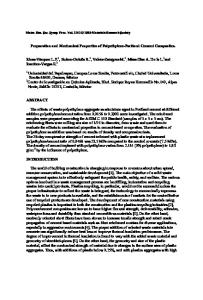Preparation, mechanical strengths, and thermal
- PDF / 1,022,490 Bytes
- 8 Pages / 594 x 774 pts Page_size
- 51 Downloads / 285 Views
I.
INTRODUCTION
IN 1980, the present authors have reported that wire-shaped amorphous alloys can be prepared for Fe 1'2-, Co 3-, and pd4'Lmetalloid and Cu-Zr 6 systems possessing a high glassforming ability by an in-rotating-water melt spinning technique. 4'7 It was subsequently found8 that the Fe- and Co-base amorphous wires exhibit unique magnetic properties different from those of the amorphous ribbon samples, even though the alloy compositions and amorphous structure of the wire and ribbon samples are exactly the same. These unique properties have been speculatively attributed8 to the difference in sample morphology and magnetic domain structure resulting from the difference in the solidification process and solidification speed. Following these encouraging findings, the ferromagnetic amorphous wires have most recently been found9'~~to exhibit a large Barkhausen effect, the Matteucci effect, and good cloth-inductor characteristics, so that these wires can be used as sensing elements in electro-magnetic devices. Owing to such functional characteristics and an establishment H of a technique of producing a continuous amorphous wire with a length of several kilometers, amorphous wires are now used ~2in many kinds of applications as functional sensing materials, and the engineering importance of the amorphous wires has been increasing significantly. Among Fe-, Co-, Ni-, and Pd-metalloid and Cu-Zr alloys in which the glass-forming ability has been confirmed experimentally ~3'~4to be high enough to produce an amorphous wire with diameter greater than 100/zm, amorphous wires of Ni-base alloys, such as Ni-Si-B and Ni-P-B, etc., could so far not be produced ~5because of fragmentation of
A. INOUE, Associate Professor, and T. MASUMOTO, Professor, are with The Research Institute for Iron, Steel and Other Metals, Tohoku University, Sendai 980, Japan. S. FURUKAWA, Researcher, and M. HAGIWARA, Chief Researcher, are with Research and Development Center, Unitika Ltd., Uji 611, Japan. Manuscript submitted June 30, 1986. METALLURGICALTRANSACTIONS A
the ejected stream before solidification in rotating water caused by the low viscosity and large surface tension. Nibased amorphous wires are expected to be of practical use as nonmagnetic strain gage sensors, wire-shaped brazing materials, and so forth. Most recently, the present authors have examined systematically the effect of small alloy additions on the formation tendency of Ni-based amorphous wires and the d~stribution of the alloy component in a thin surface layer on the rapidly quenched samples. They found that a small addition of a particular alloying element results in continuous formation of Ni-Si-B and Ni-P-B amorphous wires. The aim of this paper is to present the results on the outer surface morphology, tensile and fatigue strengths, corrosion resistance, structural relaxation behavior, and thermal embrittlement behavior of the Ni-based amorphous wires, and to elucidate the reason for the enhancement of the amorphous wire formation tendency by small alloy additions.
Data Loading...











